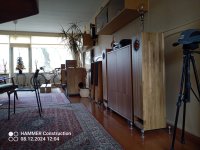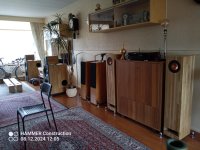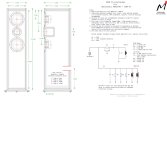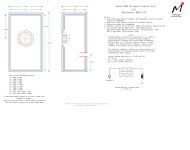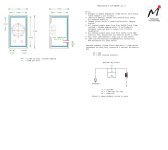Thanks for reply. My advices is probably better with a ported speaker, thats true.They're a 1/4 space - 1/8 space boundary loaded horn variation. Boundary loading is a functional part of the design -move them away and the impedance matching vanishes. A high pass at Fb will increase the rolloff from an initial 2nd order (which is why they motor down quite a long way) to something > 4th order, reducing the usable extension & not initially providing much assistance with excursion until you're below about 32Hz. Being a horn, baffle step is also already largely compensated for by the driver's own response and the broad LF gain BW. I like assisted alignments, to a point anyway, & I've even done a handful for MA, but if you're going down that route, a boundary loaded horn probably isn't the ideal basis.
No when I have you here, is the Alpair 11M a sound upgrade to chn110 on all acounts ? You can PM me ( so we dont get OT ). I think the chn110 is a fantastic sounding driver.
is the Alpair 11M a sound upgrade to chn110 on all acounts ?
No. CHN-110 is capable of going lower, is a bit smoother up top (if stock), but lacks DDR.
I’m likelu going to put CHN-110 backing FH-XL, ihave A11ms (with minor tweaks to help the top) in a set of Bernie’s solid wood Compact Floorstanders.
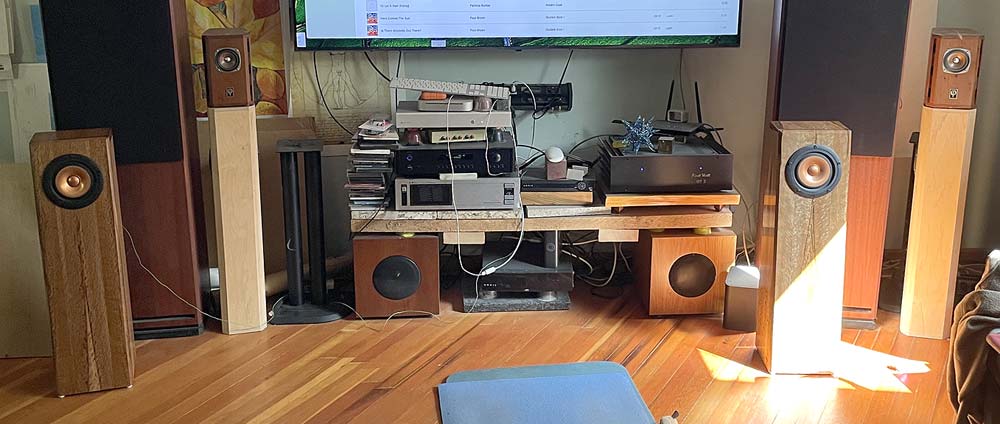
dave
Back to building the Sibelius myself, because that is what this thread is about. Here are the measurements in my room at 1 meter distance from the driver and at 0 meters from the bass port. Of course you can also see the resonances of my room. I measured here with 100 grams of longhair wool (red lines) and 78 grams (blue lines)Excellent work! Pretty impressive
Care to show us how the measured response looks like e.g . near field of the drivers and fb from the bass port? thank you ☺️
The sound of the Sibelius is very natural and spacious. I have never heard anything so beautiful! You don't want to spoil that with filters. The power of design is that the driver is connected directly to the amplifier!Biggest upgrade for the excellent Sibelius clones is a steep highpass filter below tuning frequency . This can be done with a WiiM Ultra. If fb is 35 Hz , set the stereo highpass filter for the main speakers in the subwoofer meny to 35 Hz . It will roll off below that frequency with 24dB/oct electrical. The Ultra puts out a filtered signal through spdif also, if one want to use an external dac as I do.
Now , the sound will be much cleaner and one can play louder .
I have done this with my towers ( at the moment using chn110 )
One could also use dsp to take down the +3 dB diffraction bump between 750-1000 Hz on the original Sibelius. This is depending entirely on the box size and the sides that are not rounded. This can also be done with an Ultra or WiiM PRO, using the PEQ : frequency 850 Hz , gain -3 dB, Q 3.
Also, if one wants to have their Sibelius out in the room , they need some baffel step compensation from 400 Hz and below. This can be done using the shelving function in the Ultra/Wiim PRO . Frequency 400 Hz, gain +2 dB , Q 3
https://trueaudio.com/st_diff1.htm
After done those tweaks, theres no need system matching with tube amplifiers and so on…. Just a clean class D tpa3255 will sound fine.
Back to building the Sibelius myself, because that is what this thread is about. Here are the measurements in my room at 1 meter distance from the driver and at 0 meters from the bass port. Of course you can also see the resonances of my room. I measured here with 100 grams of longhair wool (red lines) and 78 grams (blue lines)View attachment 1390561
Very nice, finally some significant information that indicates the correlation between what is measured vs. what is heard. Well done 🙏☺️
That is with 10.2 or 10.3?Back to building the Sibelius myself, because that is what this thread is about. Here are the measurements in my room at 1 meter distance from the driver and at 0 meters from the bass port. Of course you can also see the resonances of my room. I measured here with 100 grams of longhair wool (red lines) and 78 grams (blue lines)View attachment 1390561
A good dsp keeps the direkt contact with the driver - its a win-win.The sound of the Sibelius is very natural and spacious. I have never heard anything so beautiful! You don't want to spoil that with filters. The power of design is that the driver is connected directly to the amplifier!
Im sure that some dsp filtering and PEQ can make the Sibelius sound even better.
Nice to see some relevant measurements 1 meter from the Sibelius speaker.
I hope your measurements is with only one speaker active ?
What microphone did you use ?
A dsp would surely make the sound even better . In not saying that a flat response is the best , far from it, but the -5 dB dip at 3,5 kHz would sound better with a -3 dip instead. And that diffraction peak at 850 Hz ( + 2,5 dB ) coming from the geometry of the box is also easily bettered with some mild help of PEQ.
All of you with the Sibelius that have a dsp : Just print frequency : 850 Hz , gain : - 2,5 dB , Q: 3 . And PEQ = frequency : 3,5 kHz , gain +2 dB , Q= 1
Try it and come back for report.🙂

* the dropping curve is only the bass port.
We see diffraction at 850 Hz and a bit to little energy at 3.5 kHz .
Edit: this frequency response is rather similar to the chn110 driver that I have.
I hope your measurements is with only one speaker active ?
What microphone did you use ?
A dsp would surely make the sound even better . In not saying that a flat response is the best , far from it, but the -5 dB dip at 3,5 kHz would sound better with a -3 dip instead. And that diffraction peak at 850 Hz ( + 2,5 dB ) coming from the geometry of the box is also easily bettered with some mild help of PEQ.
All of you with the Sibelius that have a dsp : Just print frequency : 850 Hz , gain : - 2,5 dB , Q: 3 . And PEQ = frequency : 3,5 kHz , gain +2 dB , Q= 1
Try it and come back for report.🙂
* the dropping curve is only the bass port.
We see diffraction at 850 Hz and a bit to little energy at 3.5 kHz .
Edit: this frequency response is rather similar to the chn110 driver that I have.
Last edited:
Blue = more stuffing = less output, no?I measured here with 100 grams of longhair wool (red lines) and 78 grams (blue lines)View attachment 1390561
Well, if your filtering /EQ is upstream or even inside the amp, then isn’t that connection still direct?The sound of the Sibelius is very natural and spacious. I have never heard anything so beautiful! You don't want to spoil that with filters. The power of design is that the driver is connected directly to the amplifier!
Red is more stuffing (100 grams) and more output. More important; the resonance frequencies are equally high, what means that the transmission line and the bass port are tuned to the driver.Blue = more stuffing = less output, no?
With dsp the Sibelius will probably have a flatter characteristic, but also sound flatter (and shriller), which means you lose the natural sound / you lose the magic of this speaker! I had Harbeth speakers before, which are also known for their natural sound and they had the same characterstic in my room! I only used a lf-dsp with my rel sub, which is no problem, because it's only for the low frequencies.A good dsp keeps the direkt contact with the driver - its a win-win.
Im sure that some dsp filtering and PEQ can make the Sibelius sound even better.
You many be right about this, but small corrections with a good dsp ( read WiiM ultra ) that doesnt do sample rate conversion, can possibly make the sound even better . If it doesnt, then fine.🙂. You will still have direct connection to the amplifier and driver.With dsp the Sibelius will probably have a flatter characteristic, but also sound flatter (and shriller), which means you lose the natural sound / you lose the magic of this speaker! I had Harbeth speakers before, which are also known for their natural sound and they had the same characterstic in my room! I only used a lf-dsp with my rel sub, which is no problem, because it's only for the low frequencies.
Its a win-win to try it .
I just encourage people to try it out , and I can only say that my tower speakers with chn110 went better sounding with dsp ( It was rather good sounding without it, also ) .
With dsp, the resulting sound made me sell my expensive Genelec SAM monitors.
Last edited:
Just wait till the drivers hit Xmax > and then wonder what has happened to all the money you spent !!!Youtube influencer guy and stereo reviews Sibelius. Spoiler alert, he likes it:
In fairness, nothing very dramatic. a/ Xmax is a [not especially meaningful] figure for linear deflection, not the limit of mechanical travel, and b/ the drivers have built-in arrestors that indicate when you've reached rated Xmax.
Of course, if you want large amounts of LF dynamic range, especially in big rooms, then you need to buy a larger speaker with at least the same LF extension & larger (or greater number of) LF drive units -no mysteries there, just a law of physics. But not everybody wants / needs that, and I suspect most buyers do understand that if they need more on those lines, then a relatively compact standmount or floorstander with a 5 1/4in driver isn't likely to suit them.
Of course, if you want large amounts of LF dynamic range, especially in big rooms, then you need to buy a larger speaker with at least the same LF extension & larger (or greater number of) LF drive units -no mysteries there, just a law of physics. But not everybody wants / needs that, and I suspect most buyers do understand that if they need more on those lines, then a relatively compact standmount or floorstander with a 5 1/4in driver isn't likely to suit them.
Last edited:
- Home
- Loudspeakers
- Full Range
- Pearl Acoustic Sibelius
